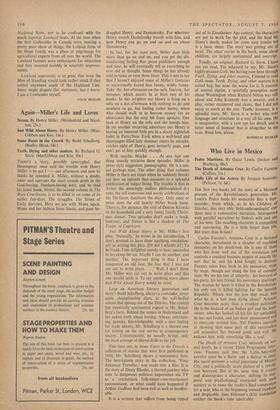Who Live in Mexico
The Death of Artemio Cruz. By Carlos Fuentes. (Collins, 21s,) Daily Life of the Aztecs. By Jacques Soustelle. (Pelican, 7s. 6d.) THE first two books tell the story of a Mexican peasant of the Revolutionary generation. Mr. Lewis's Pedro feeds his memories into a tape' recorder, from which, as in his Children 01 Sanchez, this very able 'field-anthropologist' cuts them into a consecutive narrative, interspersed with parallel narratives by Pedro's wife and one of his sons. The resulting character is compelling and convincing. He is a little larger than life. But truer than fiction?
Carlos Fuentes's Artemio Cruz is a fictional character, introduced in a chapter of rambling memories on his death-bed. He is one of those who has' done well out of the revolution and controls a crooked business empire of exactly the sort that he and his kind fought to destroY. Fuentes takes him back in his memories, stage by stage, though not along the line of calendar time. We see his loss of integrity: his betrayal of his party, his best friend; his mercenary marriage, The woman he loves is killed in the Revolution; his only son is killed fighting for the Spanish Republic. Which was the loss that made 011 what he is, a lost man dying alone? Artemio Cruz becomes more than a crooked politician. He is the bastard of an Indian girl and the land" owner, who has looked all his life for sothething, he has not found, and has done unmeasured evil to everyone around him. Yet Fuentes succeeds in showing that some part of this remorseless old scoundrel lies beyond good and evil. Ile endows him with something like a soul.
The Death of Anemia Cruz succeeds on self- eral levels. In a recent Third Programme inter- view, Fuentes said that the Latin-American novelist must be a Butor and a Balzac at once' His novel presents a social panorama of Mexico City, and a politically acute picture of a revolu- tion betrayed. But at the same time it creates and disintegrates a character, shifting its ten': poral and psychological viewpoint with such mastery as to rouse the reader's final compassinn for a, man who at the beginning seemed repulsive and despicable. Sam Iiilernan's (US) translation catches the book's tone admirably. Oscar Lewis is also fortunate in the trans- lator of his scripts, which are rendered in an authentically chunky homespun. His talent is that of a brilliant cutter. His introduction and Perfunctory interpretation of Pedro Martinez's Character, written in flat psychologist's jargon, should be read only after Pedro has spoken for himself. Like Mr. Lewis's earlier subject Jesus Slinchez, Pedro has tremendous integrity and a sense of family responsibility that makes him share a last measure of maize with a distant relative. He is converted from Catholicism to Seventh Day Adventism by reading the Bible and discovering where the priest found the words that he had learnt by heart from his sermons. Hut Pedro believes at the same time that a charm Pushed secretly into a but wall can cause disease or a miscarriage. An enthusiastic politician, he knows when to duck his head for fear of bullets. Thus Mr. Lewis raises reportage to the pro- Portions of a novel; Carlos Fuentes carries the novel into the field of historical and meta- Physical inquiry; and both tell engrossing stories.
So does Jacques Soustelle, whose excellent Daily Life of the Aztecs now comes back as a Pelican. So much of Mexican village life is rooted in pre-Conquest beliefs and attitudes that to understand Martinez one must look back to the Aztecs and beyond. For 600 years or more the highest Mexican virtue has been to accept and endure. Martinez's children will perhaps be the lust generation to hope and construct.
J. M. COHEN































 Previous page
Previous page